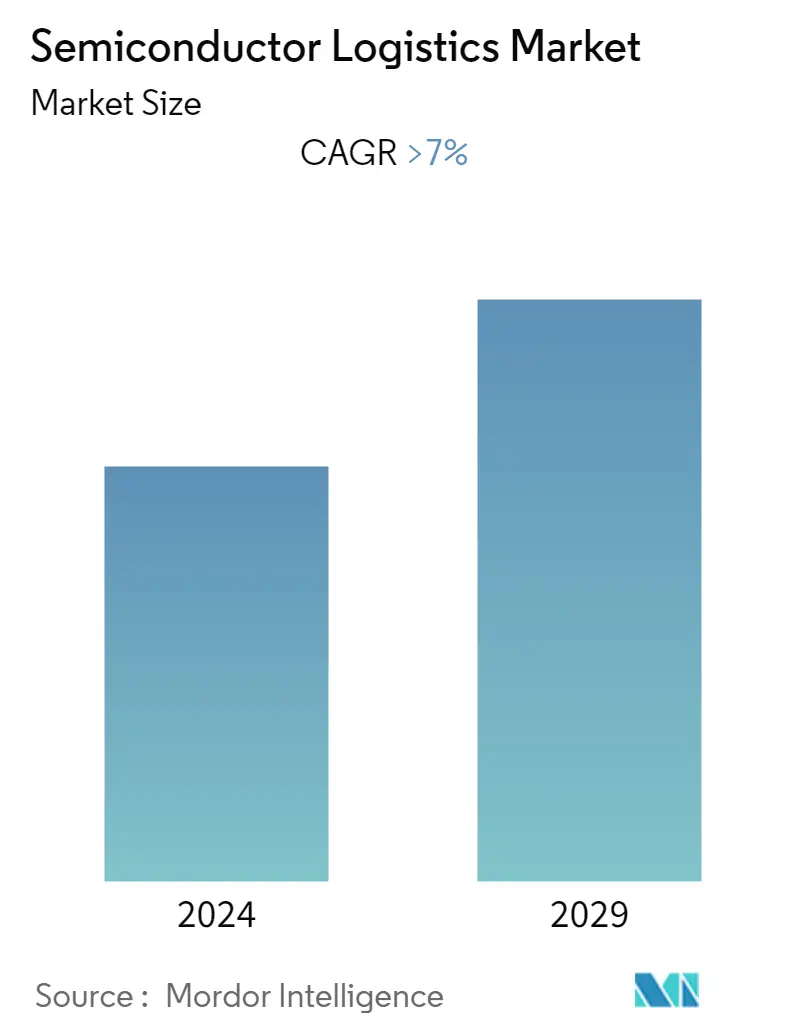Market Size of Semiconductor Logistics Industry

| Study Period | 2020 - 2029 |
| Base Year For Estimation | 2023 |
| CAGR | > 7.00 % |
| Fastest Growing Market | Asia-Pacific |
| Largest Market | North America |
| Market Concentration | Low |
Major Players*Disclaimer: Major Players sorted in no particular order |
Need a report that reflects how COVID-19 has impacted this market and its growth?
Semiconductor Logistics Market Analysis
The Semiconductor Logistics Market is anticipated to register a CAGR of more than 7% over the forecast period. The market is driven by the huge demand for semiconductors from different segments. Furthermore, the market is driven by the huge opportunities in logistics improvement to cater to the manufacturing and supply chain in the semiconductor industry.
- There has been an increasing demand for smart devices, the need for sustainable production methods, the importance of cultivating a talent pool, and growth in APAC's semiconductor market share will shape the semiconductor logistics industry. However, supply chain and labour disruptions caused by COVID-19 had resulted in a worldwide chip shortage crisis, which had been exacerbated by ongoing trade tensions between the US and China, as well as conflict in Russia. The pace of technological advancement will quicken. The construction of 5G networks and the Internet of Things has already laid the groundwork for connectivity and automation.
- Insufficient manufacturing capacity to meet market demand is a key thematic trend permeating many facets of the semiconductor supply chain. Semiconductors are essential components in many renewable energy applications, electric vehicles, smartphones and other personal electronics, data centres, and even defence weapons. However, behind the scenes, today's semiconductor companies are facing a slew of challenges. Even at full capacity, fabs have been unable to meet demand, resulting in product lead times of six months or longer. The ongoing semiconductor shortage is now making headlines regularly, especially when it forces automotive OEMs to delay vehicle production. Furthermore, semiconductor firms are dealing with increased design complexity, a talent shortage, and pandemic-related issues, all of which are disrupting the complex, global supply chain that connects players in different markets.
- The semiconductor industry must see the logistical challenges of the last two years as a wake-up call that drastic action is required. When COVID-19 went into effect, many businesses saw a significant drop in sales. The automotive industry lost 80% of its buyers, resulting in a sharp drop in semiconductor demand. Some predict a global semiconductor shortage that will last until 2024. Between 2020 and 2022, it was estimated that these shortages cost the global economy more than USD 500 billion. Worse than the immediate financial impact, these shortages have revealed that semiconductor supply chains are inadequate. Several obvious flaws have been exposed, and addressing them requires more than simply catching up on order backlogs.
- The future of semiconductor companies is dependent on finding a way to compete with logistical challenges as a signal that drastic action is required. Because the demand for semiconductors is only going to increase, those who can get them to end users more efficiently will be the ones to benefit the most in the coming years. The semiconductor value chain is unusually complex, relying on a global network of material and equipment suppliers. This makes efficient supply chain management extremely difficult, resulting in excess stock and routine bottlenecks. A good example is freight management. Freight issues, ranging from port congestion to container shortages, can result in longer lead times and longer shipment delays. Other factors influencing the supply chain include humidity, shock impact, and theft. But without precise data on the progress of shipments and GPS tracking, leaders are often left operating in the dark.
